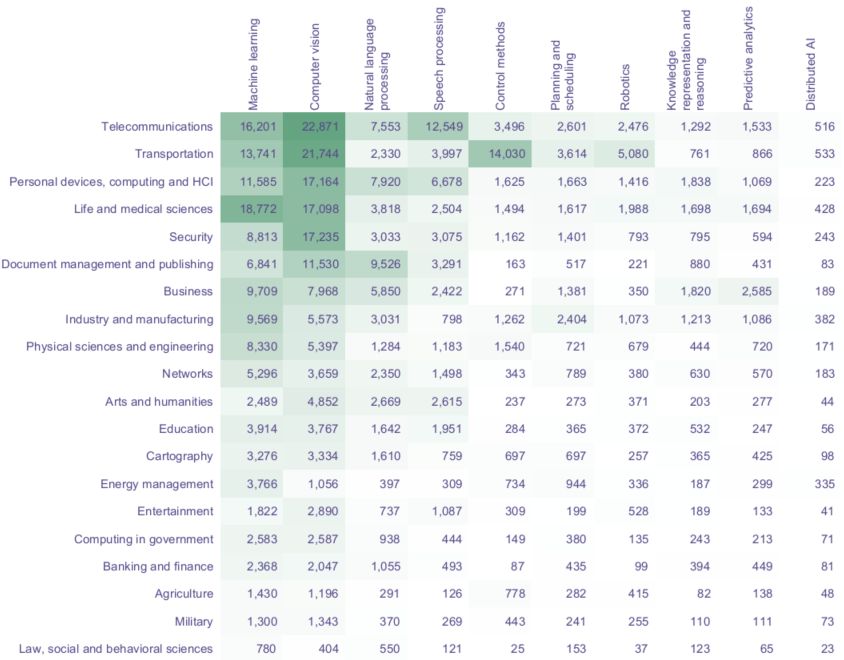Artificial Intelligence (AI) has become increasingly important to companies and institutions of all sizes and industries. AI is reshaping the business and consumer landscape -- from the application of machine learning for speech recognition in the retail industry (for ordering products from smart home devices), to the application of convolutional neural networks (CNNs) for computer vision in the robotics and automobile industries (enabling autonomous driving), and the use of neural networks in the pharmaceutical industry (to identify new targets in drug discovery).
Between 2012 and 2017, patent application filings claiming AI technologies grew by an average of 28% per year. Although AI technologies are being developed in virtually every industry, the bulk of these filings are sectors including telecommunications, transportation, personal electronic devices and computing, life and medical sciences, security, document management, manufacturing, and engineering. Key AI technologies include machine learning, computer vision, natural language and speech processing, control methods, planning and robotics, among many others.
The chart below lists the number of patent families of AI technologies by industry and field.

*[Data courtesy of WIPO Technology Trends 2019: Artificial Intelligence. Geneva: World Intellectual Property Organization]
In its 2019 Technology Trends report, the World Intellectual Property Organization (WIPO) noted that the growth of AI will be fueled by a profusion of digitized data and rapidly advancing computational processing power, with potentially revolutionary effects: more accurate weather forecasting, improved crop yields, enhanced detection of cancer, early predictions of epidemics and greater industrial productivity.
Overview of how AI works
AI is fundamentally a data-driven technology that takes unique datasets as input to train AI computer models. Once trained, an AI computer model may take new data as input to predict, classify, or otherwise output results for use in a variety of applications.
As visualized below, machine learning, arguably the most widely used AI technique, may be described as a process that uses data and algorithms to train (or teach) computer models. The trained model allows the computer to make decisions without the need for explicit or rule-based programming. In particular, machine learning algorithms build a model on training data to identify and extract patterns from the data, and therefore acquire (or learn) unique knowledge that can be applied to new data sets.

Because of the reliance on data to train AI models, information and data sources are now an even more important and valuable resource. Companies that collect or store data (e.g., "big data"), incorporate information arising from the Internet-of-Things, or otherwise have large, unique datasets are typically well-positioned to develop or take advantage of AI technologies.
There are multiple AI learning techniques, including supervised learning, unsupervised learning, and reinforcement learning.
Legal aspects of AI inventions in the United States
AI inventions are generally patentable in the United States, however, because they involve computer and software-related features, care must be taken regarding the U.S. Supreme Court's subject matter eligibility test under 35 U.S.C. § 101, as provided in Alice Corp. v. CLS Bank International.
For example, under Alice, an important test is whether the claims of a computer or software related invention recite a specific improvement to "the functioning of a Computer itself" or "any other technology or technical field." Nonetheless, since Alice, the U.S. Court of Appeals for the Federal Circuit has found numerous computer and software related inventions patent eligible.
Further, in the U.S. Patent Office (USPTO)'s 2019 Revised Patent Subject Matter Eligibility Guidance (January 7, 2019), the UPSTO provides an example AI-based method for training a neural network for facial detection, that is patent eligible under Alice. See USPTO, Subject Matter Eligibility Examples: Abstract Ideas, Example 39.1
In general, in view of Alice, when considering AI inventions for patent protection, a patentee should focus on the unique technical features that may be identified in an AI-invention workflow and related components. These may include, for example:
- The pre-processing of training data (e.g., preparing unique datasets for input into a particular AI algorithm)
- The training process (e.g., improvements or adjustments to a machine-learning or neural network algorithm)
- The application of trained models (e.g., to control machines or to provide unique results)
- The hardware that executes a trained AI model, including any improvements to the hardware or its deployment in a given technical field
AI technology may also be protected by copyright, whether or not registered with the United States Copyright Office. For example, AI data that is arranged in a predetermined format to meet preprocessing concerns to train an AI model, would be subject to copyright upon being fixed in tangible form.
AI algorithms and data are entitled to state and federal protection as trade secrets. Maintaining the secrecy and restricted use of this information, however, requires a higher level of vigilance and procedures than apply to
Footnotes
1. [Link: https://www.uspto.gov/sites/default/files/documents/101_examples_37to42_20190107.pdf]
The content of this article is intended to provide a general guide to the subject matter. Specialist advice should be sought about your specific circumstances.

